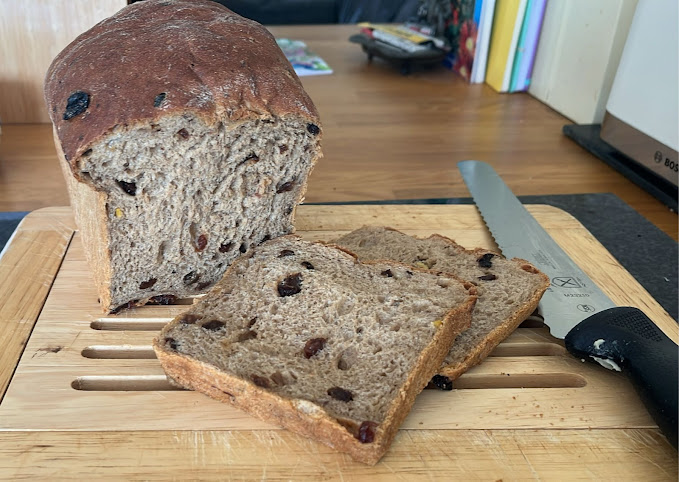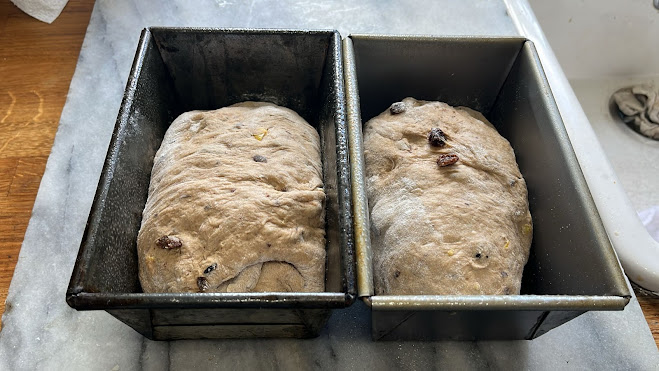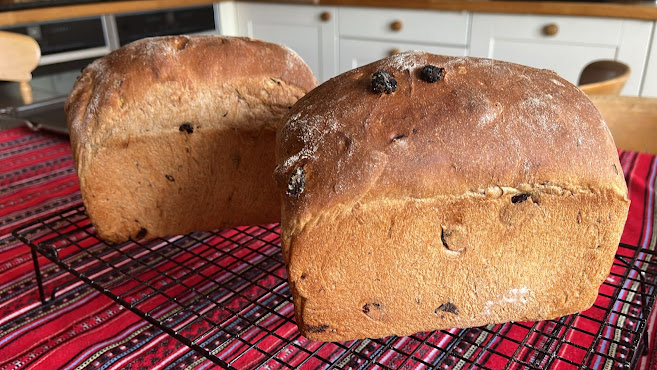Lincolnshire Plum Loaf
Welcome to another step-by-step recipe from BreadClub20. Why not drop by our main Facebook page by clicking here... If you like what you see and enjoy the recipe, we hope you join us by 'Liking' and 'Subscribing'.
 |
| Alford, in Lincolnshire, England |
 |
| Charles Myers |
Together with his sons, Reg and Lewis, they milled their own flour and baked bread in what became known as Myers Mill.
From Alford to Southery and then to Mareham Le Fen, the business finally settled in Horncastle, where it still exists today.
 |
| The original Myers Mill |
 |
| Lincolnshire Poacher Cheese. |
The Lincolnshire Plum Loaf, was first baked in 1834 by Mr Slater Eyre in Louth, Lincolnshire. In 1901, it Charles Myers, developed the recipe and established the true local provenance which made it famous throughout Lincolnshire. It can be quite a dense bread - almost a cake. Fruity and moist, it's often accompanied slathered in the best butter and served with a slice of Lincolnshire Poacher cheese.
Today, there are quite a few variations on the original recipe available across Lincolnshire. They all contain varieties of dried fruit, tea, butter and spices. Some go further and include lard and milk - more about that later.
The original Plum Loaf would have been made using lard; after all, Lincolnshire is known for its pig farming and is famous for its sausages. These days, butter is often substituted for lard, reducing the fat content in these health-conscious times
The original Plum Loaf would have been made using lard; after all, Lincolnshire is known for its pig farming and is famous for its sausages. These days, butter is often substituted for lard, reducing the fat content in these health-conscious times
Another interesting fact is that in the 1600s, the word 'plum' was given to a cake or bread that contained any form of dried fruit, not necessarily plums. In the Lincolnshire Plum Loaf, we use prunes as well as other dried fruit.
A few words about the ingredients and the process:
Do we need to pre-soak the fruit? In times past, all recipes would advocate you soaked the fruit 'to make it plump and juicy before draining and adding to the dough. Remember that presoaking affects the hydration, and this has to be allowed for in the recipe. Set the correct hydration and adding the fruit in its dried state will benefit the gluten development and also, over total mixing and proving time, will still produce soft and tasty fruit that holds together better than that which has been pre-soaked.
Tea or milk? Most Lincolnshire Plum Loaf recipes will recommend either black tea or Earl Grey (also as a pre-soaker). I like using both tea and milk as it adds richness to the dough, and the milk removes any bitterness from the tea.
Salted or unsalted butter? Always unsalted. Using salted butter will always produce too salty an end product. There are one or two recipes for Lincolnshire Plum Bread that advocate using salted butter and also require an overly high level of salt overall.
Butter or Lard? In the 19th and 20th centuries, many housewives and bakers would use lard as it was far cheaper than butter. In Lincolnshire, lard was in good supply. After all, it's a county known for its pig farming and for its sausage and bacon industries. In our health-conscious age, butter is a far better option. You'll notice that I've cut down on the total quantity of butter used...for the same reason.
How sweet should the loaf be? if you compare recipes for Lincolnshire Plum Loaf, you'll see many that ask for an extraordinary quantity of sugar. Add that to the sweetness of the fruit, and you'll understand why I have reduced the sugar content considerably.
Where are the plums? In the 17th century, the term 'plum' was used for the inclusion of any dried fruit. Raisins, sultanas, currants...here we use prunes, which are, after all, dried plums that retain their high sugar content, juiciness and stickiness.
Eggs? Eggs are sometimes included to help develop the texture of the dough and also to act as a gluten inhibitor in the same way as fat would. However, I feel they really are not necessary in this recipe. If you do use eggs, remember not to bake at a high temperature. Eggs affect the baking time, crisping the crust and making for a very dark outer layer.
Salt? I always use sea salt. However, I am aware that in some parts of the world, sea salt is hard to find and very expensive. If you are using table salt or cooking salt, remember that it often contains an anti-caking agent (E-554), which is sodium aluminosilicate. Some table salts may also be fortified with iodine, which can impart a slight taste. However, both additives are deemed to be safe. It's your choice, after all.
And, finally, the spices? This is a recipe that asks for allspice, often found in Christmas pudding. I've decided to mix it with mixed spice, which is a combination of spices, rather than a single spice. If you prefer, you can simply use all-spice. However, cinnamon is intrinsic to the overall taste, and a little ginger is always welcome.
INGREDIENTS
the dough
500 gms strong bread flour
300 gms Earl Grey tea
95 gms of milk
25 gms Muscovado sugar
30 gms of melted unsalted butter
6 gms fine sea salt (or equivalent in Kosher salt)
10 gms instant active yeast, or 15 gms dried yeast, or 32 gms fresh yeast
the fruit
70 gms pitted prunes, roughly chopped
70 gms raisins
70 gms sultanas
Thinly pared and chopped rind of one lemon
the spices
3 gms ground cinnamon (1 UK teaspoons)
1 gm allspice (½ UK teaspoon)
1 gm mixed spice (½ UK teaspoon)
1 gm ground ginger (½ UK teaspoon)
2½ gms vanilla extract (½ UK teaspoon)
for serving
best salted butter
Lincolnshire Poacher cheese or a good quality Cheddar cheese.
METHOD
1. NOTE: There is no need to soak the fruit. Simply pit and chop the prunes into smaller pieces and mix thoroughly with the lemon pith, raisins and sultanas.
2. Mix the milk, sugar and melted butter. Add the spices, salt and vanilla extract and continue to mix together.
3. Add the instant active yeast to the flour and mix until well combined.
If using dried or fresh yeast, remember to activate it first.
4. Add the mixture from (2) above to the flour/yeast mixture and bring together.
5. Knead well until you have a soft and silky dough. Then spread the dough on a lightly-misted board, sprinkle the dried fruit over the dough and work in until it is all combined and evenly distributed.
6. Transfer the dough to a lightly oiled bowl, cover and leave in a warm place to double in size. The time it takes will depend on the temperature. However, cinnamon also extends the proving time.
7. Once doubled, turn out onto a floured board and knock back (de-gas)
8. Divide into two and shape for large loaf tin(s) (or, alternatively, more smaller loaf tins) and leave for a second proof to more or less double in volume.
when ready for the oven, they will have proved nicely:
9. Preheat the oven to 185⁰C (375⁰F) and bake for 30 minutes until golden brown and hollow when tapped underneath. Internal Temperature should be about 98⁰C (210⁰F).
10. Remove from the oven and cool on a wire rack.
11. Serve sliced, buttered and accompanied by a good cheese. It's the traditional way.
Happy baking.
And, from the taste testers?











Wonderful post and photos. This looks amazing!
ReplyDeleteDelish
ReplyDelete